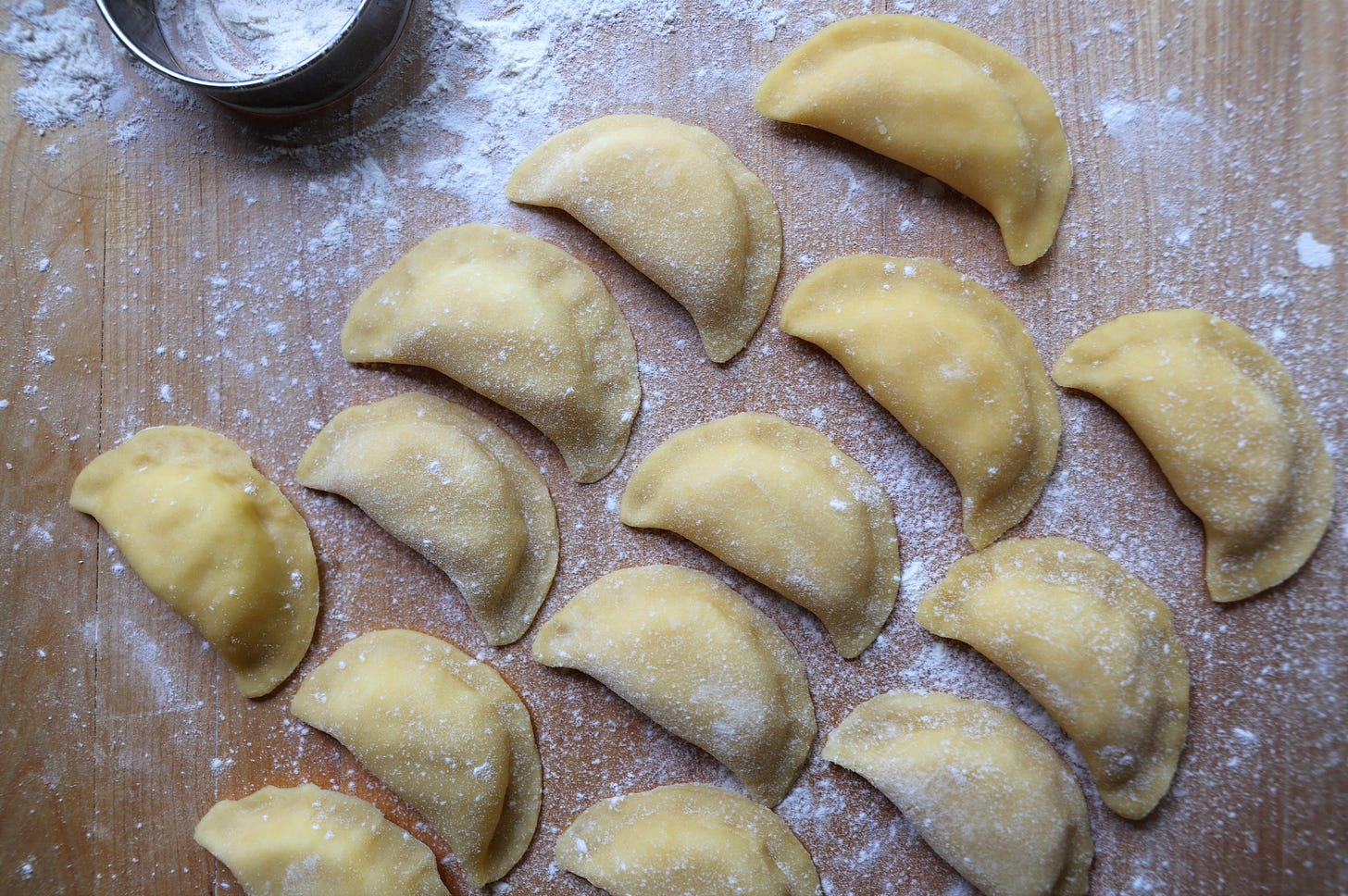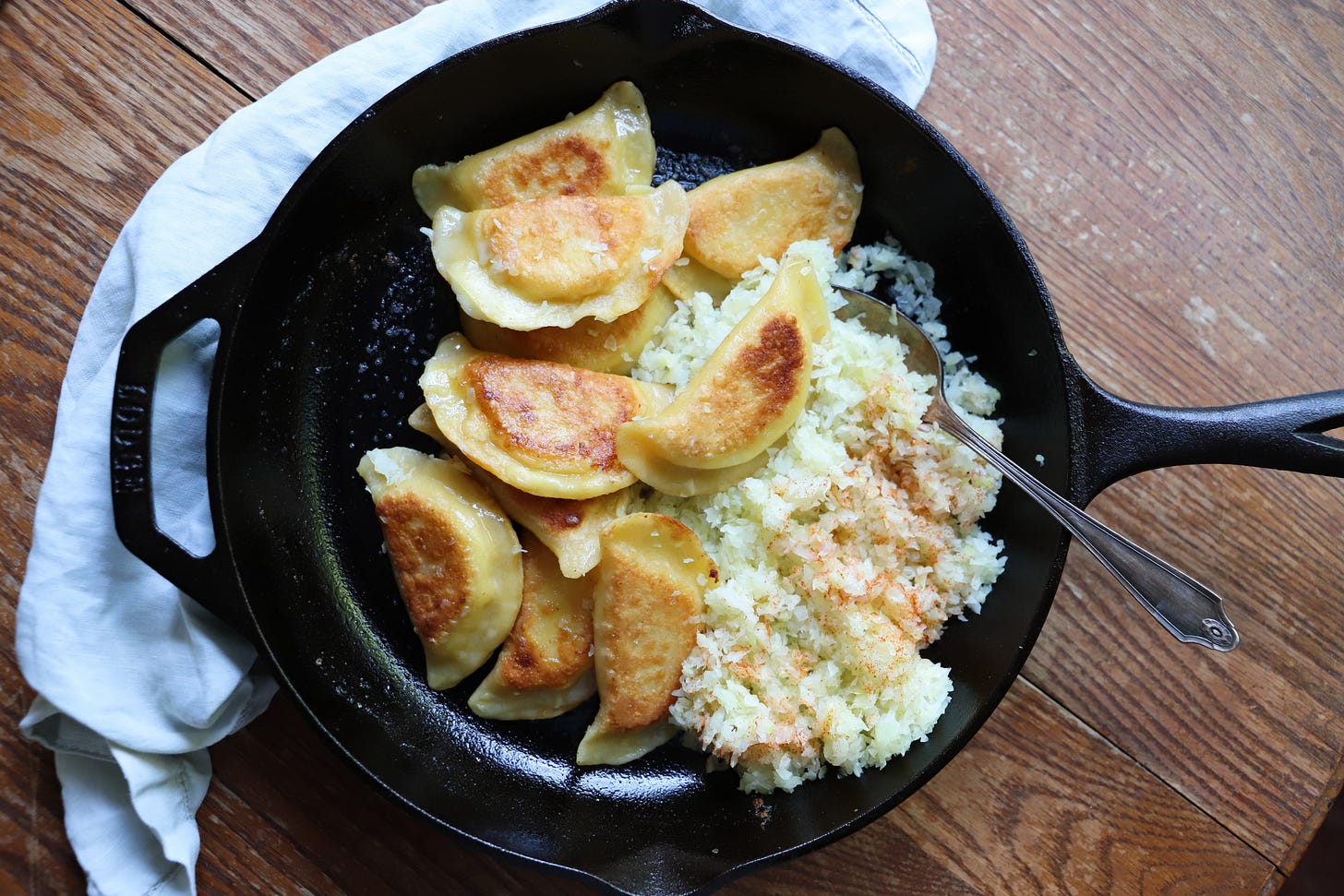It has taken me 5 years to share this recipe. A recipe can be written, tested, and live in a notebook for years before seeing the light of day. This pierogi recipe was developed before I had kids, and as it was more of a home cooked meal vs. a restaurant mainstay, so it sat. Patiently waiting to be unearthed, to be brought back into the kitchen when I had just a little more time. The story of how Chef’s create, document, and share is always a journey. Ultimately, it’s a tiny fragment of time compared to how long and far this recipe has traveled to be a part of the foods I call my own. My influences as a Chef are informed by my surroundings, my travels, and always, the foods I grew up eating.
Like many Americans, my family and the foods I identify as family recipes, immigrated to this country. The story of immigration, however long past they may be, have lasting impacts on a family and how we identify our traditions. My last name, for example, is a product of bad translation (or perhaps careless immigration officials) at Ellis Island. The foods I seek comfort in are rooted in the story of my great-grandparents and their history. My cravings for sour cream and doughy dumplings reveal my Eastern European ties, while my preference for British television with tea and toast, I like to think, are genetically linked to my English and Welsh maternal line.
With my family came their recipes, their foods, their reminders of home. Like many Eastern European families, the newly named Otawka’s settled in and around the Pittsburgh area. Hungarian, Czech, and Slovakian recipes dotted the landscape of my childhood despite my upbringing in the Mojave dessert of California, far from the Carpathian Mountains or the eastern seaboard. Nutroll was always served around Christmas; crushed walnuts mixed with cinnamon and sugar, snuggly blanketed in a butter enriched dough, baked and served warm with black coffee. Cabbage rolls, halushki, sweet paprika spiked broths, and sour cream laden sauces are still what I crave most. And while none of these are common American main stays, the Pierogi seems to have found cross over success. This potato filled dumpling is easy to eat and beloved by many. Potatoes, dough, butter. What’s not to love.
The pierogi I grew up eating came from the frozen food section. Filled with potato and onion or potato and cheese. Brought to life in a pot of salted boiling water, sometimes seared, and always topped with butter, sour cream and an optional side of cabbage or kielbasa. The joys of Eastern European cooking, conveniently made for the masses! I always loved those half mooned dumplings. But as with most things, making this meal from scratch makes for a better result. Beyond its homemade superiority, there is something special about making the dough, a tradition that is tactile. A dough made the way my great-grandmother would have made it. I may never have met her, but I know her through a recipe.
COOK THIS: PIEROGI
Yield- Around 30
INGREDIETS & METHOD:
THE PIEROGI FILLING
4 tablespoons butter, divided
1 medium yellow onion, finely diced
2 medium russet potatoes, about 12 ounces worth
2 ounces grated sharp cheddar
1 tablespoon of either heavy cream, half/half, or whole milk
1 teaspoon kosher salt
Heat 2 tablespoons of the butter in a small pot over medium heat. When melted add in the diced onion and stir. Cook, stirring often, until onions begin to caramelize and change into a light brown color, about 20 minutes. Set aside.
Peel and cut potatoes in half lengthwise and place in a pot. Cover potatoes with water and bring to a boil over high heat. Cook until potatoes are tender, about 18 minutes. Drain potatoes from water and add them back into the pot. Add in the reserved 2 tablespoons butter, cheddar, cream, salt, and caramelized onion. Use a potato masher to mash until smooth; a few little lumps are ok. Check seasoning and set potatoes aside until ready to fill pierogi dough.
*Filling can be made ahead of time and kept in fridge until ready to use and then lightly reheated to room temperature to make it easier to portion.
PIEROGI DOUGH
2 cups All-purpose flour
¼ teaspoon kosher salt
1 egg
½ cup sour cream
4 tablespoons butter, melted
In a mixing bowl, stir the flour and salt to combine. Set Aside
In another smaller mixing bowl, whisk together the egg, sour cream, and melted butter until thoroughly combined. Pour mixture into flour and stir together to form a dough. Turn out onto counter top and use hands to knead dough until smooth, about 3 minutes. Wrap dough in plastic wrap and let rest in fridge for at least 30 minutes. Dough can be made the day before.
ASSEMBLY OF THE PIEROGI
Use a large rolling pin to roll out the pierogi dough until about 1/8 inch thick evenly across, use flour as needed to prevent dough from sticking. Use a 3 inch (give or take) bicuit cutter to cut rounds out of the dough. Take excess dough scraps and knead back together to form a ball and repeat process one more time (its helpful when punching out the rounds to cut as close as possible to one another to maximize dough yield).
Arrange dough rounds on work surface and place about 1 tablespoon of filling in center of each round. Use your fingertip to lightly brush the bottom of dough round with water(this will help with the sealing). Working with one round at a time, gently fold over the top half of the dough round to encase filling and press to seal onto other half of dough. Repeat this process until all dough rounds are folded and sealed. Dip the prongs of a fork in flour and crimp the sealed edge of each pierogi, this makes a more attractive pierogi and also insurce a proper seal. After this step is complete I like to lightly press my fingers flat onto top of pierogi to flatten the top so when searing in pan they will lie flat.
If not cooking right away, pierogis can be kept a towel lined tray in fridge, be sure not to stack on top of one another to avoid them sticking to one another.
COOKING THE PIEROGIE’S
Fill a large container with ice water and set aside.
Bring a large pot of water to a boil. Add in half of pieroies and lower heat to keep them at a steady simmer. The pierogies will begin to float, continue to let them cook for about 25 seconds before removing them and placing in the ice bath. Repeat process for remaining pierogies.
Drain the pierogies from ice bath and lightly pat dry with a tea towel. Toss pierogies with just a bit of oil to prevent them from sticking. At this point you can sear straight away or keep in fridge until ready to serve.
To sear: Heat a large sauté pan over medium heat. Add in about a tablespoon of oil and a tablespoon of butter. When butter is foaming add in enough pierogis , top part facing down, and cook until crispy and golden brown. Flip pierogies over and cook until crispy and golden brown as well. Remove pierogies and keep warm until ready to serve.
*the picture shows these pierogi serve with slow cooked cabbage, message me for a simple how to on making it






